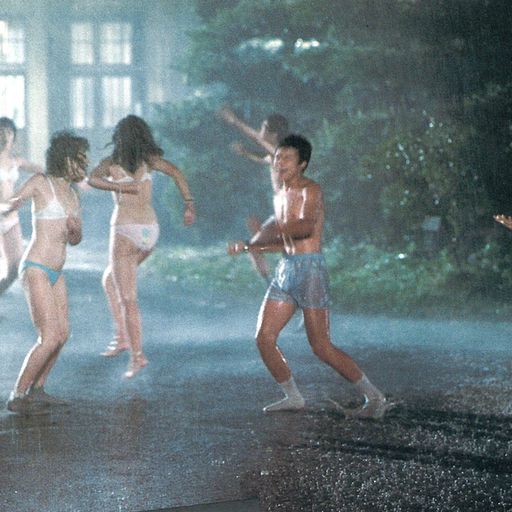
Japan Society’s spring programme, Rites of Passage: The Films of Shinji Somai allows audiences to remember the works of a pioneering Japanese filmmaker, who remains largely unrecognised in the West. Shinji Somai directed some of the most enduring works of the Eighties and Nineties instilling a contemplative approach into the seishun eiga (youth film) genre. One of his masterpieces, that provides a caustic immersion into the lives of disaffected junior high students on the cusp of adulthood, is Typhoon Club.
This 1985 motion picture — considered as Somai’s seminal feature — takes place in the five-day period before, during and after a seemingly liberating typhoon. This violent atmospheric phenomenon enacts an osmosis with the turbulent interactions of the students, who are marooned in their school gymnasium.

The first part of the film introduces the characters and their daily lives. Kyoichi (Yuichi Mikami) is the zealous student who is concerned about his university admissions; Ken (Shigeru Benibayashi) is the athlete who is tormented by love; Akira (Toshiyuki Matsunaga) does all he can to entertain his classmates; Rie (teen idol Yûki Kudô), embodies the ditzy who spends time with her girlfriends Mikami (Yuichi Mikami), Michiko (Yuka Ohnishi), and Junko (Kaori Kobayashi). We also get a glimpse into the life of their young teacher Umemiya (Tomokazu Miura). The second part of the film takes off when the typhoon catches some of the students at school. The story thus develops on multiple levels, as scenarios of romantic rivalries entangle with the externalisation of adolescence experienced in an increasingly chaotic world.
Typhoon Club captures with sensitivity and rawness the impact of growing up. Excruciating anguish, budding sexuality, rising social tensions, all coalesce in an existential intrigue that reverberates in a tumultuous storm. The rain ultimately acts as a rejuvenating catharsis, that dispels the fears and anxieties of the intimate tempest lived by each of the youngsters.
Being alive is conjoined by the awareness that death is always looming, as one of the characters says: “Death precedes life, it is life’s precondition.” This morbid presence lingers prominently, builds into a crescendo and ultimately bursts into a climax at the end of the film. What began with an innocent dance around a pool on the notes of Barbee Boys’ Kurayami De Dance, and traverses the lectures on the Pythagorean Theorem, culminates in a series of origami cranes that instead of bearing good news hover as a memento mori.

Typhoon Club, after almost forty years from its release, remains a modern work in the way it depicts a perturbed fresco of the rebellious feelings of the age that stands on the threshold of adulthood. Puberty can be unfair, the transition period can be stressful and it marks a critical and foundational period for development. Somai majestically shows the way peer relationships become increasingly important, and how at the same time the years of middle school are the loneliest ones that an individual may experience.
During the year of its release, Typhoon Club was showing at the Tokyo International Film Festival, where it won Best Film. Bernardo Bertolucci was part of the Jury that selected it, and his comment to the film captures full-heartedly the reaction any viewer may have to this cinematic narrative: “It’s one of the most beautiful and touching teenage films I’ve ever seen. An absolutely devastating film, I would say violent.” In this manner, Shinji Somai genuinely conveys the way infantile naivety confronts the brash impulse for independence in the face of the unknown.
Final Grade: A

